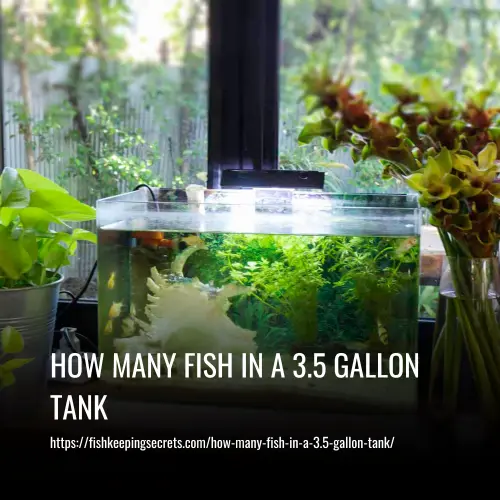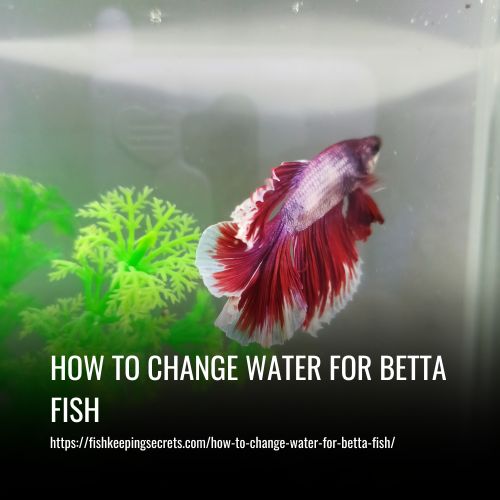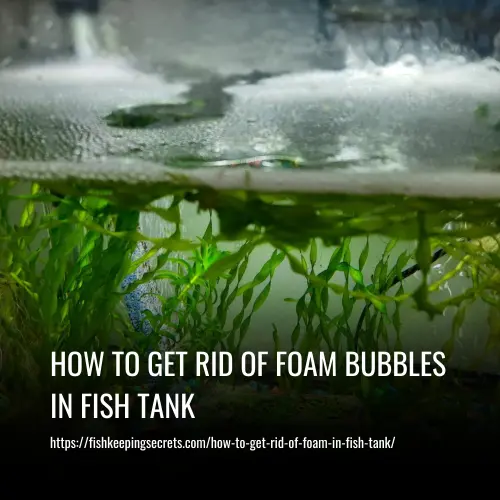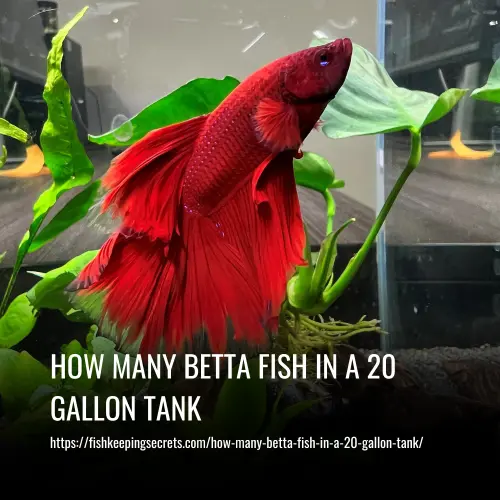How Many Fish in a 3.5 Gallon Tank
This post contains affiliate links. As an Amazon Associate, we earn from qualifying purchases.
In a 3.5-gallon fish tank, it is recommended to keep only one small fish or a maximum of two very small fishes. Keeping more fish than this can cause stress, poor water quality, and even death.
Owning a fish tank is a beautiful and fascinating hobby. Before you start, you must consider the size of the aquarium you’ll need. It’s essential to know how many fish can fit in that aquarium to ensure proper living conditions for your aquatic pets.
A 3. 5-gallon aquarium is a small tank and can be challenging to maintain. You need to take care of the essential aspects, including filtration, heat, lighting, and of course, the fish’s number. Adding too many fish to a small aquarium can lead to ammonia spikes, which can cause the fish to become stressed, sick, and ultimately die.

Factors To Consider For Stocking A 3.5 Gallon Tank
Are you planning to set up a 3. 5-gallon tank but unsure about how many fish it can accommodate? Well, the number of fish you can keep in a 3. 5-gallon tank depends on several factors. Let’s dive in and understand these factors.
1. Water Parameters
Maintaining the right water parameters is critical for the health and well-being of your fish. Before selecting fish for your 3. 5-gallon tank, make sure you understand the following:
- Water quality: The water in your tank should be clean and free from any pollutants. Ensure that you cycle the tank before adding any fish to establish beneficial bacteria.
- Temperature: Different fish species come from different parts of the world and require specific temperature ranges. Generally, a temperature of 72-82°f is ideal for most tropical fish.
- Ph levels: Different fish species require specific ph levels. Generally, most fish prefer ph levels between 6.5-7.5.
2. Compatibility
Some fish species are more compatible than others, and it’s essential to choose fish that will coexist peacefully in your 3. 5-gallon tank. Here are some factors to consider:
- Aggressiveness: Certain fish species can be more aggressive than others, and it’s essential to choose peaceful fish for a small tank like a 3.5-gallon.
- Similar temperament: Fish that have a similar temperament tend to coexist better. For example, bottom-dwelling fish like bettas are usually not compatible with active swimmers like tetras.
- Size: Choosing fish that are similar in size will reduce aggressive behavior and ensure peaceful coexistence.
3. Size And Activity Level
The size and activity level of the fish you plan to keep are crucial to determine how many can safely occupy a 3. 5-gallon tank. Here are some factors to keep in mind:
- Fish size: A 3.5-gallon tank is small, so it’s essential to choose fish that stay small. At least 1-2 gallon space per inch of fish length is necessary for good health and proper growth.
- Activity level: Active fish like danios require more swimming space than docile fish. It’s crucial to consider the activity level of the fish you plan to keep.
Understanding the above factors can help you select the right fish species for your small aquarium. Remember to avoid overstocking your 3. 5-gallon tank to ensure your fish remain healthy and thrive.
Estimating The Number Of Fish For A 3.5 Gallon Tank
1. Rule Of Thumb
When it comes to estimating the number of fish for a 3. 5-gallon tank, there is a general rule of thumb that suggests keeping one inch of fish per gallon of water. However, this rule should be approached with caution, especially when dealing with smaller tanks like a 3.
5-gallon.
Here are some things to consider:
- The rule of thumb does not always apply to smaller tanks, like 3.5-gallons, since there is less water to dilute waste products and accommodate fish’s specific needs.
- As a result, overstocking a small tank could lead to poor water quality, growth stunting, disease, and other adverse consequences for your fish’s health and behavior.
- Other factors like filtration, aeration, and water chemistry should also be considered when determining how many fish can safely inhabit a 3.5-gallon tank.
2. Fish Size
The size of your fish is a critical factor that influences how many fish can live comfortably in a 3. 5-gallon tank.
Here are some key points to consider:
- Smaller fish, such as guppies, tetras, and bettas, generally do well in a 3.5-gallon tank because they require less swimming space. For instance, you could keep three to four guppies or a single betta in a 3.5-gallon tank.
- Larger fish, such as goldfish, angelfish, or cichlids, require more swimming space, making them unsuitable for a 3.5-gallon tank. Overcrowding the tank with large fish could lead to ammonia spikes, poor water quality, and stunted growth.
- Other fish that could do well in a 3.5-gallon tank include snails, shrimps, and other species that do not require as much swimming space.
3. Type Of Fish
Different species of fish have different requirements for space, and their behavior also plays a role in how many fish can be kept in a 3. 5-gallon tank.
Here are some things to consider:
- Some species of fish are more docile and can coexist peacefully in small spaces, while others are territorial and aggressive, requiring more space to establish their territories.
- Bottom-dwelling fish like catfish or loaches may require more space or hiding areas, while top-swimming fish like tetras may not require as much space.
- Mixing different species of fish that occupy different water levels or have distinct behaviors could be challenging and potentially harmful.
Estimating the number of fish for a 3. 5-gallon tank is not a straightforward matter. Before deciding on how many fish to keep in a tank, considering the three factors discussed above is critical. Remember, overcrowding may lead to poor water quality, stunted growth, disease, and other adverse consequences that could harm your fish’s health and behavior.
Suitable Fish For A 3.5 Gallon Tank
1. Betta Fish
Betta fish are vibrant and visually appealing, making them great for small aquariums such as a 3. 5-gallon tank. Here are some key points to consider when selecting betta fish for your tank:
- Betta fish have low activity levels, making them well-suited for smaller tanks.
- Ensure that you have only one male in the tank to prevent conflicts and fighting.
- Females can be kept together or with males in a larger tank with plenty of hiding places.
- They prefer a water temperature between 75-82°f, and a ph level between 6.0-7.5.
2. Guppies
Guppies are colorful and easy to take care of, making them a popular choice for small tanks like a 3. 5-gallon one. Here’s what you need to know about keeping guppies in your aquarium:
- Guppies are small and grow to be approximately 1-2 inches in length, making them ideal for small tanks.
- They prefer a water temperature between 72-82°f, and a ph level between 7.0-8.2.
- Adequate filtration is essential to maintain good water quality, which is essential for the health of your guppies.
- Guppies can breed rapidly, so ensure you have ample space if they give birth to fry.
3. Endler’S Livebearers
Endler’s livebearers are great for small tanks like a 3. 5-gallon aquarium because they are small and have a peaceful temperament. Here are the key points to consider when selecting endler’s livebearers for your tank:
- They require a temperature range between 72-82°f, and a ph level between 6.5-8.5.
- An important aspect of their diet is vegetable matter, and they will thrive with a balanced diet.
- Ensure that you have only one male in the tank and provide plenty of hiding spots to reduce conflict.
- They are active and enjoy swimming in schools, so consider adding a few to your tank.
Keeping fish in a 3. 5-gallon tank can be a challenge, but with the right fish and care, it is achievable. Betta fish, guppies, and endler’s livebearers are great options for small tanks. Remember to keep their environment healthy and balanced by cleaning the tank regularly, maintaining the proper temperature, and providing them with a variety of food to keep them healthy and happy.
Maintaining A Healthy 3.5 Gallon Tank With Fish
Keeping your fish healthy and happy is essential to their well-being. If you have a 3. 5 gallon tank, it’s important to maintain it properly to ensure your fish thrive. Here are some tips on how to maintain a healthy 3.
5 gallon tank with fish.
1. Water Changes
Regular water changes are vital to maintaining water quality in your tank. Fish produce waste, which can quickly build up and harm them if left unattended. Here are some key points to keep in mind when it comes to water changes:
- Change out about 20-30% of the water in the tank every week to help remove toxins and keep the water clean.
- Use a siphon to remove debris from the bottom of the tank during water changes.
- Make sure to add a water conditioner to remove any chlorine, chloramines, or heavy metals from the water.
2. Tank Maintenance
Maintaining your tank is also crucial to the health of your fish. Here are some important points to consider when it comes to tank maintenance:
- Clean the tank regularly to remove algae and debris. Use an aquarium-safe brush to scrub the inside of the tank, and rinse the gravel with water.
- Replace the filter cartridge at least once a month to ensure it’s working correctly.
- Keep an eye on the water temperature to ensure it remains between 75-80 degrees fahrenheit.
3. Feeding
Choosing the right type of food and feeding your fish the correct amount is the final piece of the puzzle for a healthy 3. 5 gallon tank. Take a look at these key points:
- Feed your fish once or twice a day, only giving them enough food that they can eat in 2-3 minutes.
- Avoid overfeeding your fish, which can cause uneaten food to decay and harm the water quality.
- Choose food specifically formulated for your type of fish to ensure they receive the necessary nutrients.
By following these simple steps, you can maintain a healthy 3. 5 gallon tank for your fish, which will ensure they are happy and healthy for years to come.
FAQs
It is recommended to have only one fish in a 3. 5-gallon tank to ensure that the fish has enough space to swim and thrive. Overcrowding the tank can lead to poor water quality and stress on the fish.
Adding multiple fish to a 3. 5-gallon tank is not recommended as it can lead to overcrowding and poor water quality. This can negatively impact the health and wellbeing of the fish.
It is recommended to clean a 3. 5-gallon fish tank every one to two weeks. This includes changing 25-50% of the water and using a gravel vacuum to remove any debris or uneaten food.
Small and peaceful fish such as a betta fish or a small school of tetras can thrive in a 3. 5-gallon tank. It is important to research the specific needs and compatibility of any fish before adding them to the tank.
No, a 3. 5-gallon tank is not appropriate temporary housing for larger fish. The lack of space and water quality issues can lead to stress and health problems for the fish. It is best to provide appropriate housing for the size of your fish.
Conclusion
After analyzing the factors that determine how many fish can be kept in a 3. 5 gallon tank, it is clear that it is important to exercise caution and responsible decision-making when it comes to housing fish. Overstocking a tank can lead to a host of issues that can harm the fish and compromise their health.
It is important to consider factors such as filtration, water quality, and the specific needs of each type of fish before determining a suitable number for a particular tank. While it may be tempting to add more fish to your tank, it is always crucial to prioritize the well-being and comfort of the fish over a desire for aesthetic appeal.
By adhering to responsible stocking practices, you can create a healthy and thriving aquatic environment for your fish to call home. Remember, a happy and healthy fish is always worth the extra effort!






